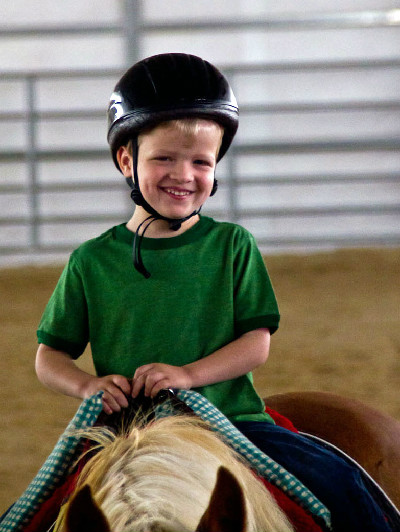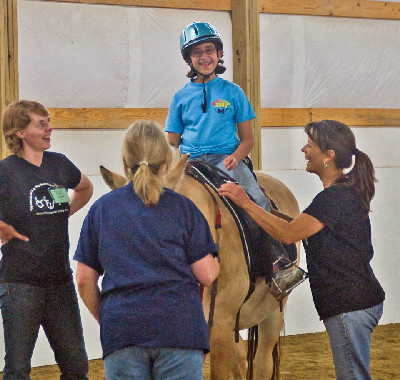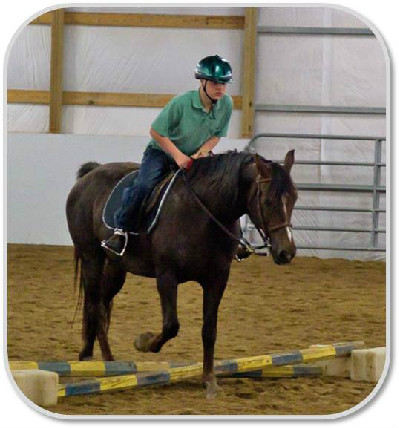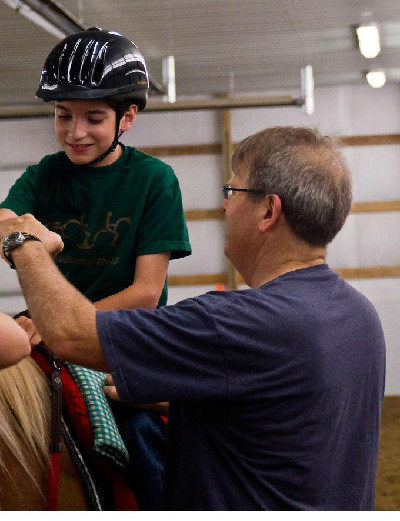Dream Jobs: Helping Others as a Therapeutic Riding Instructor
by Karen Braschayko
Have you ever wanted a job that makes you feel completely satisfied at the end of the day, knowing you did something good and helped others? Jan Vescelius has this gratification every day as director and head therapeutic riding instructor at Therapeutic Riding, Incorporated (TRI) of Ann Arbor, Michigan. Therapeutic riding provides physical, cognitive and emotional benefits to individuals with disabilities. She has helped guide TRI through a major expansion that included building a specifically designed facility and creating a solid plan for future growth. Here she explains why working hard to serve others is so rewarding.

A rider at Therapeutic Riding, Incorporated of Ann Arbor, Michigan.
Karen Braschayko for Equitrekking: How is being a therapeutic riding instructor a dream job?
Jan Vescelius: It is a dream job for me. You’re not going to get terribly rich doing it, but if you want something that is fulfilling, and you can be happy with it at the end of the day, therapeutic riding is a great choice. If you feel good about it and you can make a living doing it, then yes, it’s a dream job. I can incorporate all of those things I love and what I love about life into what I do, including the horses, obviously.
The biggest perk is how good I feel just working the job. Where else can you come in, have people appreciate what you do, and feel like you’re doing something worthwhile for someone other than yourself? I personally love it. It’s very selfish, but I love my job. It’s very rewarding, and what more can a person ask for?
Equitrekking: What is your background with horses, and how did you become a therapeutic riding instructor?
Jan Vescelius: I lived in Europe as a teenager and rode junior jumpers for four years. I came home and built my own hunter facility. I’ve been a professional in the hunter industry since 1973, so I went into therapeutic riding with a lot of horse background but very little therapeutic background. I taught people of all ages, beginners to advanced riders. I did all of that for years and made my mistakes.
I was at a point where I had kids, my own farm and my own business. In the late 1970s or early 1980s, I read about therapeutic riding in a magazine, and it struck me. I thought, wow, they are right on, and this is something you could actually reach outside of yourself and do for somebody else.
It was a new concept for me at the time, and it grew from there. This isn’t just about me, and it’s not about me making money doing it. It’s not just about me making somebody reach the finals on some circuit, so they can hang another ribbon on their wall. I can actually do something good. If you believe in providence, it was something like that. It just had to be, because it was magical.

Jan Vescelius, right, teaches a therapeutic riding lesson.
I helped start Lenawee County’s therapeutic riding program as a volunteer. I just wanted to volunteer because I was having children and running a business, and that’s all I had time for. I helped a couple ladies who wanted to become instructors with the horse requirements. Then I decided that I wanted to become a therapeutic riding instructor.
I was certified as a therapeutic riding instructor in 1991. I lived at Cheff Therapeutic Riding Center in Augusta, Michigan, for a month. You had to pass their criteria to get there. I became a NARHA, now PATH International, Advanced Level Certified Instructor. I’m also a 4-H Proud Equestrians Program (PEP) Instructor through Michigan State University. I go after the most education that I can get, as do the other instructors at TRI.
Equitrekking: How important is being a horse person to teaching therapeutic riding?
Jan Vescelius: Horse knowledge is absolutely imperative. Safety is first, progressive education is next. I mentor no one as an instructor candidate unless they have an extremely strong horse background. That is the basis of this. You’re not going to have safe riders unless you know what’s going on with the horses. Who needs to be free lunged before you ride? Who is a little sore, a little colicky or too fresh? You need to recognize that, because safety is the baseline of all that we do. You know when horses are sound, healthy, ridden, exercised and ready to go. Only then can you have your best lessons.
You have to understand the basic mechanics of riding. You don’t necessarily have to go out and ride to third level, and you don’t even have to show, but you had better understand that when you put your outside leg back and your inside leg on for a canter depart, that the outside leg pushes the hip here, and the inside leg produces forward movement there. You have to understand the method of it, because what if you have a rider who is sitting incorrectly because their disability and it produces a result that was not intentional? An instructor must have a firm understanding of horse mechanics.
When we train our horses here, we are riding with only one objective in mind, and it’s not the perfect dressage frame or performing as a Morgan or Quarter Horse for show. Our goal is what does Dobbs need to learn today? He needs to learn to go from the walk to the trot transition on a loose rein without someone picking him up and carrying him, so that our riders can do the same when they ride him independently. That is the baseline philosophy here.
My job is as a horseman is to get my horses healthy, ridden and exercised. They have to be fit. Many people say, “Well, they just walk and trot a little.” These horses carry an unbalanced load, and they deal with tight legs, loose legs, leaning riders and pounding on their backs. They might have a lot of things that are very difficult to do over a long period of time, so they have got to be fit. So that’s part of my job.

A rider at TRI.
Equitrekking: What path do you think someone should take to become a therapeutic riding instructor?
Jan Vescelius: Volunteer. Find a good therapeutic riding center. Look at a lot of places before you decide where you’re going to volunteer. Just immerse yourself in every aspect. They’ll love you for it if you’re a horse person. They should have extensive orientations. Go be a leader, a sidewalker, and a tacking and grooming person. Go find out what it takes to do this. Don’t do it once or twice. Do it for a long time, at least a year.
Then go online to the Professional Association of Therapeutic Horsemanship (PATH) International website. Find the standards that you need to follow as a therapeutic riding instructor. Find an instructor you respect to mentor you. In the horse world, and we all laugh at this, if you ask five people you’re going to get five different opinions, but there has to be a common thread of sanity. Go out and visit, and volunteer.
Equitrekking: How has therapeutic riding touched your own life?
Jan Vescelius: My grandson Reese was born seven year ago, and he is profoundly disabled. He has Angelman Syndrome. Riding allowed him to learn to sit up. When you take him and put him on a horse, he loves it.
Reese gave me a new perspective on therapeutic riding. I taught for several years before Reese was born. It was almost like, get ready, something’s going to happen you’re going to have to deal with. Things happen for a reason. We always say, if you don’t have a child who is disabled, you can’t understand. You can try to understand, and I think we’re pretty good at understanding. You don’t know what it’s like to have a child with a disability or have a disability yourself unless you actually do, 24/7, year in and year out. Even as a grandparent, though Reese lived with me for three years, I still don’t know what it’s like.
Equitrekking: What are the biggest challenges of being a therapeutic riding instructor and the director of a program?
Jan Vescelius: The most difficult part is matching the right volunteer handlers to the horses and then matching the right volunteer sidewalkers to the horses and riders. All of that matching up and blending is a challenge. You might have personality issues, you might have body placement issues, and you have great big horse people issues. Our horse people have to learn some new techniques. They find out that maybe what they are expert at out there is maybe not what they’re expert at in here. It’s that matching of so many people to the horse and rider, that’s the hardest thing. Our goal is to keep the successful horse-rider-volunteer groups together because that is what is best for our riders’ growth and learning.
Probably the other hardest part about therapeutic riding is raising operating funds. When I want to be in the arena, sometimes I have to be in the office. You have that blending of everything that has to be done so that it all comes together in the arena. To me, that’s the focus. You make sure that everything you do, in the big picture, under the big umbrella, that everything is coming together so in the arena the rider has a progressive lesson. That’s the bottom line for me.
Another challenge is that the learning process is slow sometimes. Things don’t always happen fast in therapeutic riding for the client. Sometimes they do, but sometimes they don’t. The process is so slow sometimes. Just like any rider, our riders sometimes reach a plateau, and it’s hard to keep it fresh. Even if riders don’t like it as much and sit there with their arms folded, they’re going to get something from therapeutic riding. They talk, they walk, and they get stronger whether they want to or not. Sometimes you have situations where people are progressively getting worse, and you can only hope to delay that progression a little bit and make them stronger in another area. There is always that hope. Don’t forget the joy that riding brings to us all.

A volunteer sidewalker assists a rider.
Equitrekking: What is a typical day like for a therapeutic riding instructor?
Jan Vescelius: I get here a couple hours early. It depends on the weather. I know our grooming crew is coming in, and maybe there are horses that need a little work before lessons. I have to be in here early in case the grooming crews cannot get here or I need to help them groom and tack. I don’t ask anybody to do something I wouldn’t do. You start buddy building with volunteers right then. You have people you know and like, and you support them. There are always changes, such as a volunteer is not coming, or a horse is lame, so you have to make last minute changes. Everyone learns to go with the flow.
You have to make sure that you’re greeting riders and volunteers and that it’s all getting ready in the back. When the horse walks into the arena, everybody is calm and prepared. The riders get on, and you feel the day. That’s when it all comes together.
Then you do your teaching. You talk with parents between classes. Some parents want to know how their child is doing and if there is any growth. Talking to parents is the fun part. I also talk to the adult riders about what’s going on with our goals and what we can expect. Then you get your next group of riders mounted. It all has to happen in that quiet little venue of everybody’s having fun.
At the end of the day, you make sure your horses are in good shape, your tack is put away, the laundry is done, and the facility is clean. Was the hay ordered? Is there sawdust in the bin? That’s my day. You need to learn how to shoot from the hip and give everybody what they need. The key to success is to surround yourself with knowledgeable people and then learn to trust them and each other.
Keep in mind that instructors lift a lot of resistant weight. It’s a pretty physical job. You’ve got to stay fit. You have to devote the time to keep yourself healthy.

Jan Vescelius, center, at TRI in Ann Arbor, Michigan.
Equitrekking: How did therapeutic riding change the way you see horses?
Jan Vescelius: It made me grow as a trainer, big time. It made me look at just handling the horse on the ground. Before, groundwork wasn’t a big aspect for me, other than that horses had to be polite. Therapeutic riding made me more conscious of exactly where the horse’s body is at all times in relation to your body.
I learned a lot of new training techniques so that a large group of people can handle the horses in the same way, because that has to happen here. You have to know your horses, to learn their personalities and their quirks on a more intimate level. You have to know how they interact, what they like and what they don’t like. You think you know that — until you do therapeutic riding and you have 150 volunteers per week handling your horses.
It made me pay more attention to the horses and how they’re telling us, “I’m not feeling quite right,” or, “I’m a little off, so adjust your rider.” That’s why you have to have someone in your midst who is going to be that good with horses. Give it up, look at the horse, read the horse and pay a little more attention to them. That’s what they taught me.
You become a real detective. You’ve got to have a partnership with the leader. The horse might have the same leader all night, or she might have three different leaders in one night. You have eight sessions of three hours apiece each week. Somehow, you’ve got to make it fun for this horse. You’ve got to make them love their jobs, year after year, and it’s really hard. So for me, it made me a much better horseman.
Visit Therapeutic Riding, Incorporated at therapeuticridinginc.org. To learn more about therapeutic riding programs or find a center near you, visit PATH International at www.pathintl.org or call (800) 369-RIDE.
Karen Braschayko is a freelance writer and horse lover who lives in Michigan.




